Picture a coral reef fringed island, white sand beaches, amazing blue waters and tonnes of scuba diving right at your fingertips… Time to get the bucket list out!
Bonaire is considered one of the top shore diving sites in the world, so can you blame us for deciding to overwinter down here in the Caribbean?
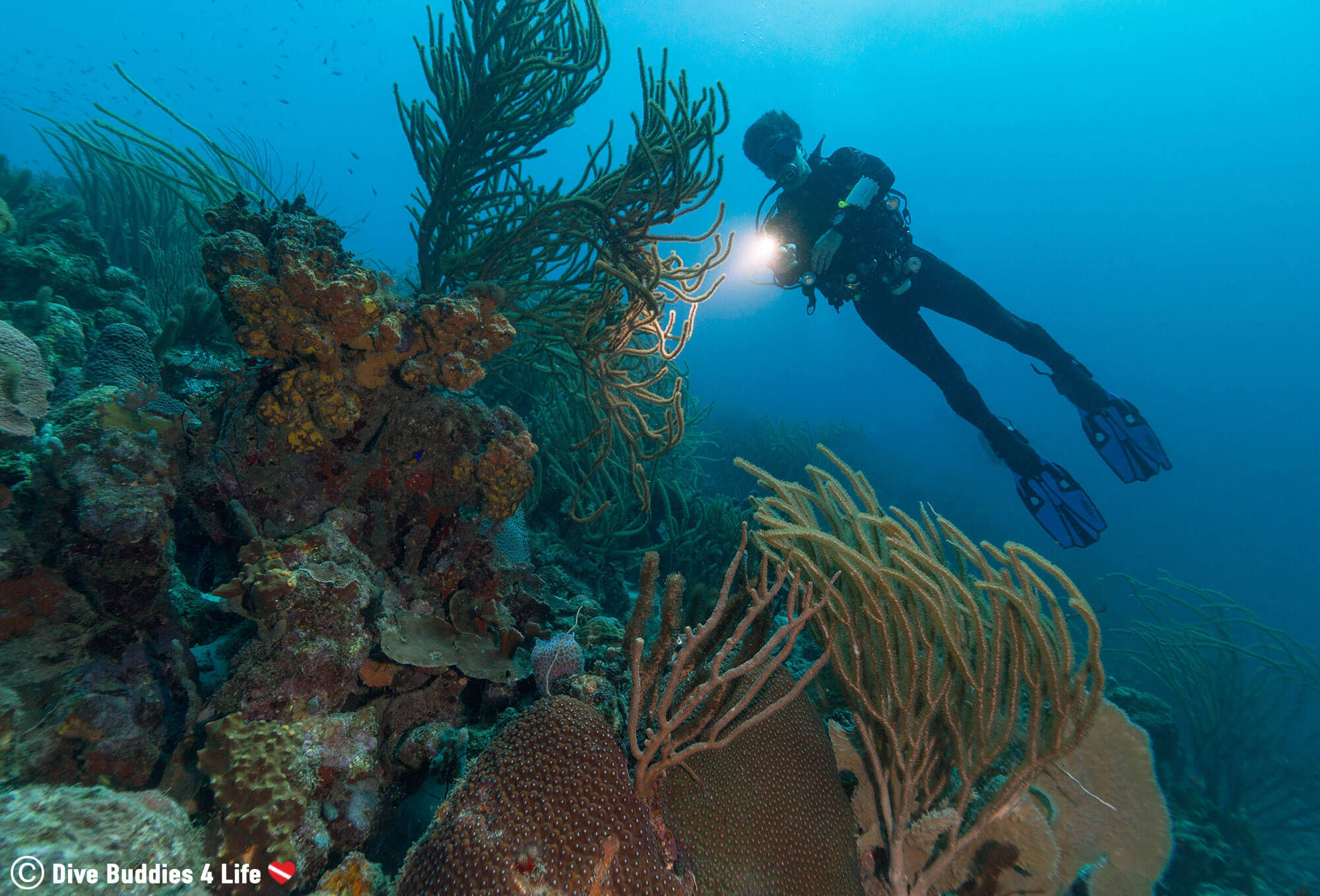
Bonaire is a small island 80 kilometers off the coast of Venezuela. Together with Aruba and Curaçao, Bonaire makes up what is known as the ABC islands – three islands of the Leeward Antilles.
As far as Bonaire may be from continental Europe, the island is considered a special municipality within the Netherlands – not a country on its own, unlike its counterparts Aruba and Curaçao, which are part of the Kingdom of the Netherlands but have their own official passport.
Of the ABC islands, most travelers agree that Bonaire is by far the more laid back of the three. Lacking in large lavish hotels and significantly fewer tourists, Bonaire, is an eco-friendly, water sports lovers paradise.
As a testament to the islands aquatic claim to fame, the waters that surround Bonaire are part of a marine protected area put in place back in 1979. This marine park includes 2,700 hectares of fringing reefs, seagrasses, and mangroves, all distinct ecosystems in dire need of protection.
Meters from the shoreline, Bonaire’s fringing reefs are home to virtually every species of hard and soft coral found in the Caribbean. The coral, in turn, provides a habitat for over 340 fish species including tarpon, frogfish, and sharks. And that’s not even counting the various species of sea turtle that nest and reside in the surrounding waters.
It’s no wonder divers come from near and far to see this hotspot of Caribbean biodiversity.
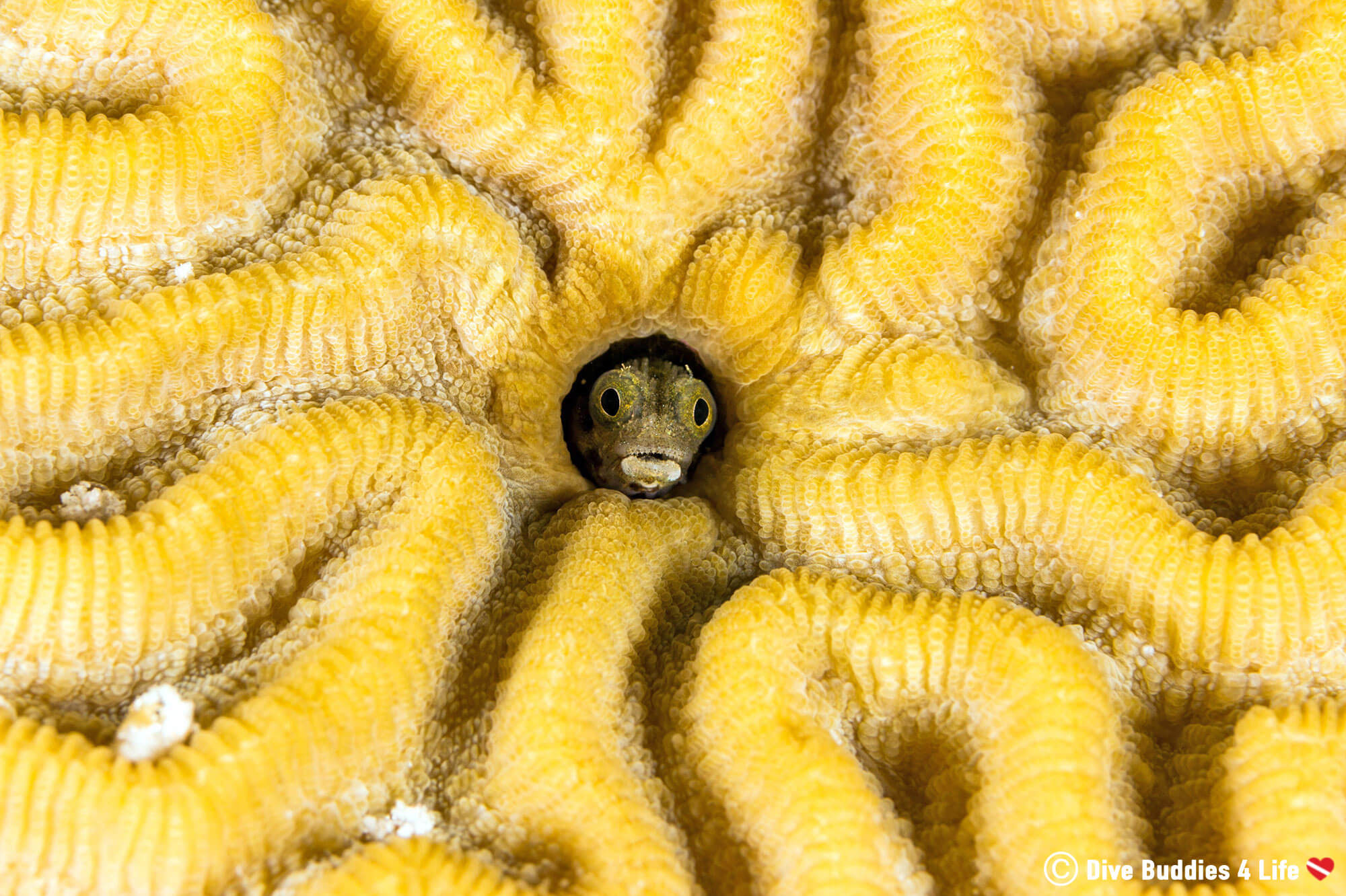
Bonaire is a surreal place with more marine life than you can shake a stick at. And it’s all thanks to Stichting Nationale Parken Bonaire (STINAPA) who manage the two protected areas of Bonaire – the Bonaire National Marine Park and Washington Slagbaai National Park.
STINAPA is a nonprofit, non-governmental foundation dedicated to the conservation of Bonaire’s natural and historical heritage.
The Bonaire National Marine Park surrounds the entire island, from the high water mark to the depth of 60 meters (200 feet). Because of this, all water-based activities on Bonaire – scuba diving and snorkeling included – occur in the marine park and are subject to the STINAPA marine park fee. The fee for scuba diving is USD 45$ and this fee allows diving and entrance into the Marine Park and Washington Slagbaai National Park for one calendar year.
Payment can be made at all dive shops on the island, STINAPA offices, the Kralendijk tourism office and the activity desk of most hotels. Once you pay your marine park fee, divers will receive a circular waterproof chip that needs to be attached in a visible location on your dive equipment. This chip needs to be on your person whenever you are on the water or underwater. In addition to the waterproof token, divers will also receive a receipt, which should be kept, because it shows proof of payment, and should be provided to the STINAPA rangers upon request.
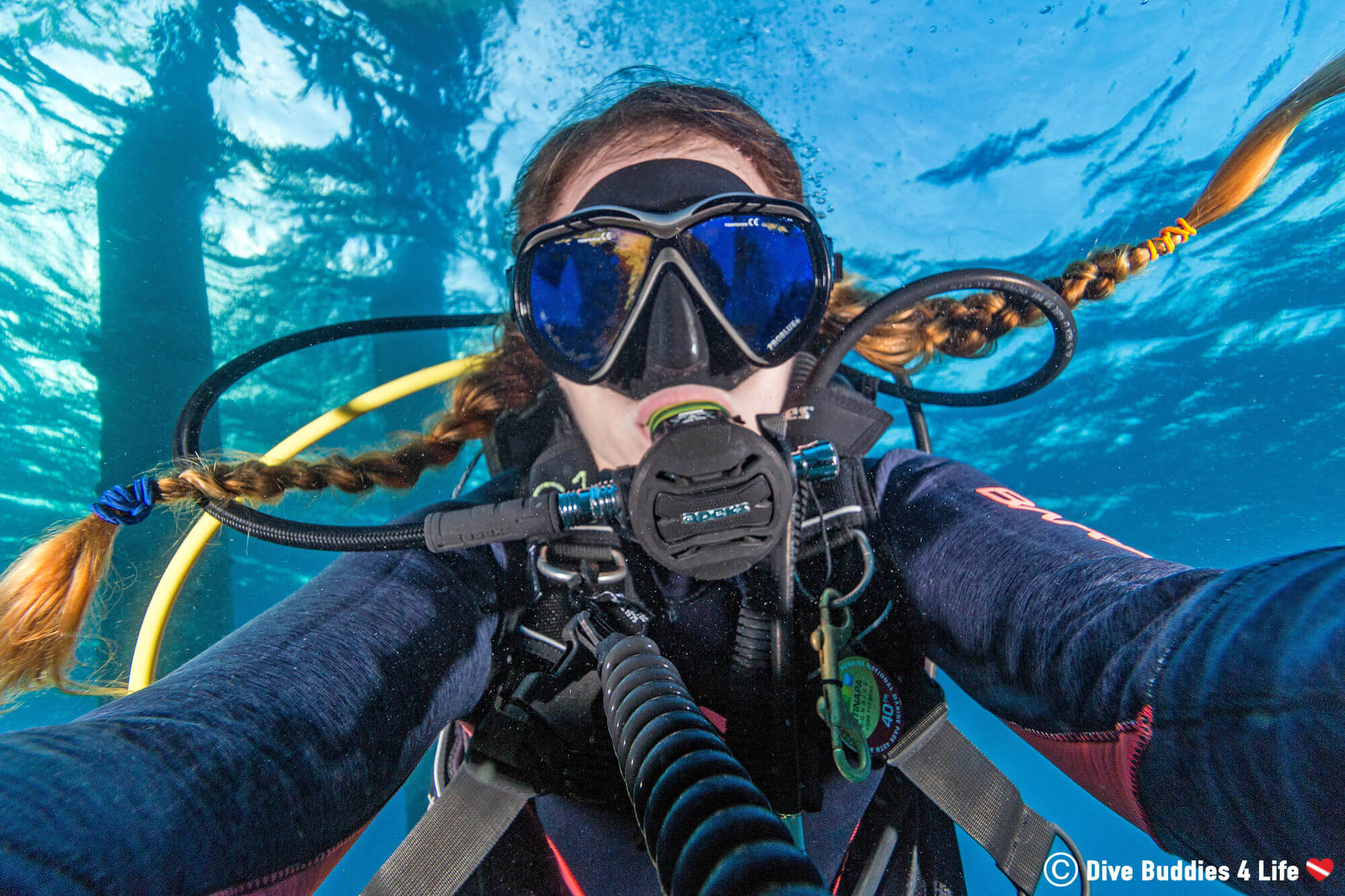
Bonaire is considered one of the best shore diving locations in North America, and arguably the world.
With colorful coral reefs that would rival a painters easel and sheltered dive sites loaded with marine life, diving here is easy as pie. In fact, the entire island is geared towards getting you into that warm 25-30°C Caribbean water.
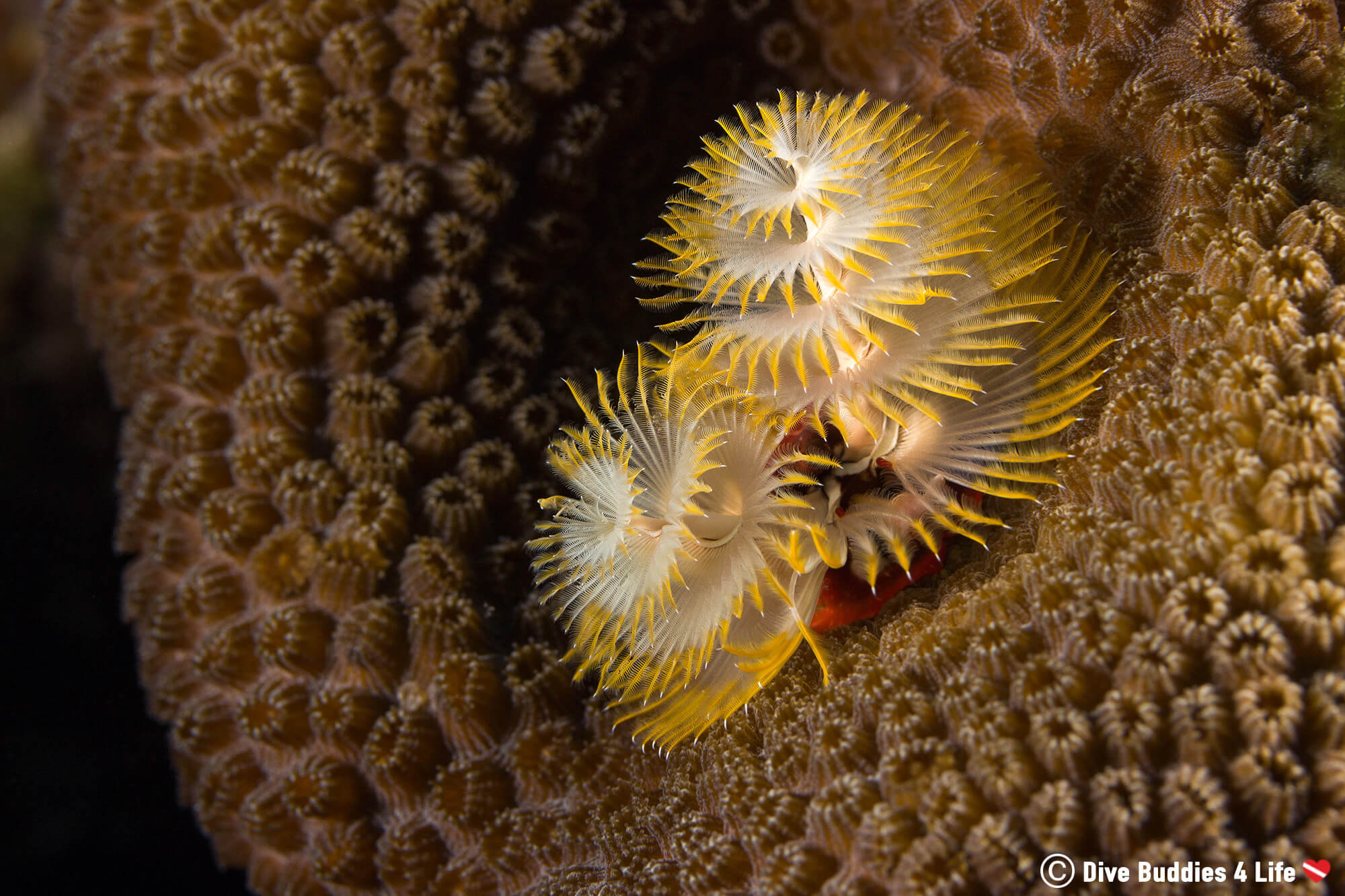
For starters, most truck rentals are equipped with tank racks and a dry egg for key storage. Dive gear pickup is done at one of the many island dive shops, drive-thru style with several loading spaces and many staff to help with the heavy lifting and changing of empty tanks.
Once your ready to hit the water, depending on the shop, divers can choose to dive either from shore or from a boat.
For shore divers, finding dive sites is hardly a problem. Yellow-painted roadside stones show the location of each dive site. Couple that with a map of the island – which by the way also shows the location of all the dive sites – and you’re well on your way to scuba success.
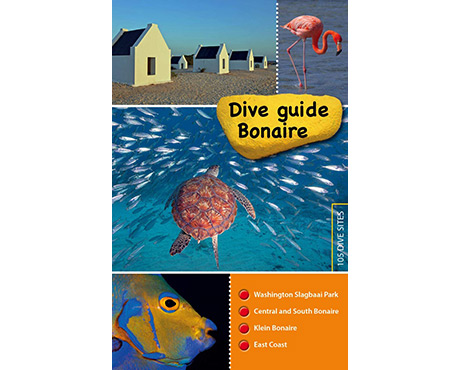
The Dive Guide Bonaire is the perfect book to take with you on your southern dive vacation. This guide describes more than 100 dive sites in Bonaire along with underwater maps and stunning photographs.
For boat divers, it’s even easier. Merely load your gear on the boat, and away you go!
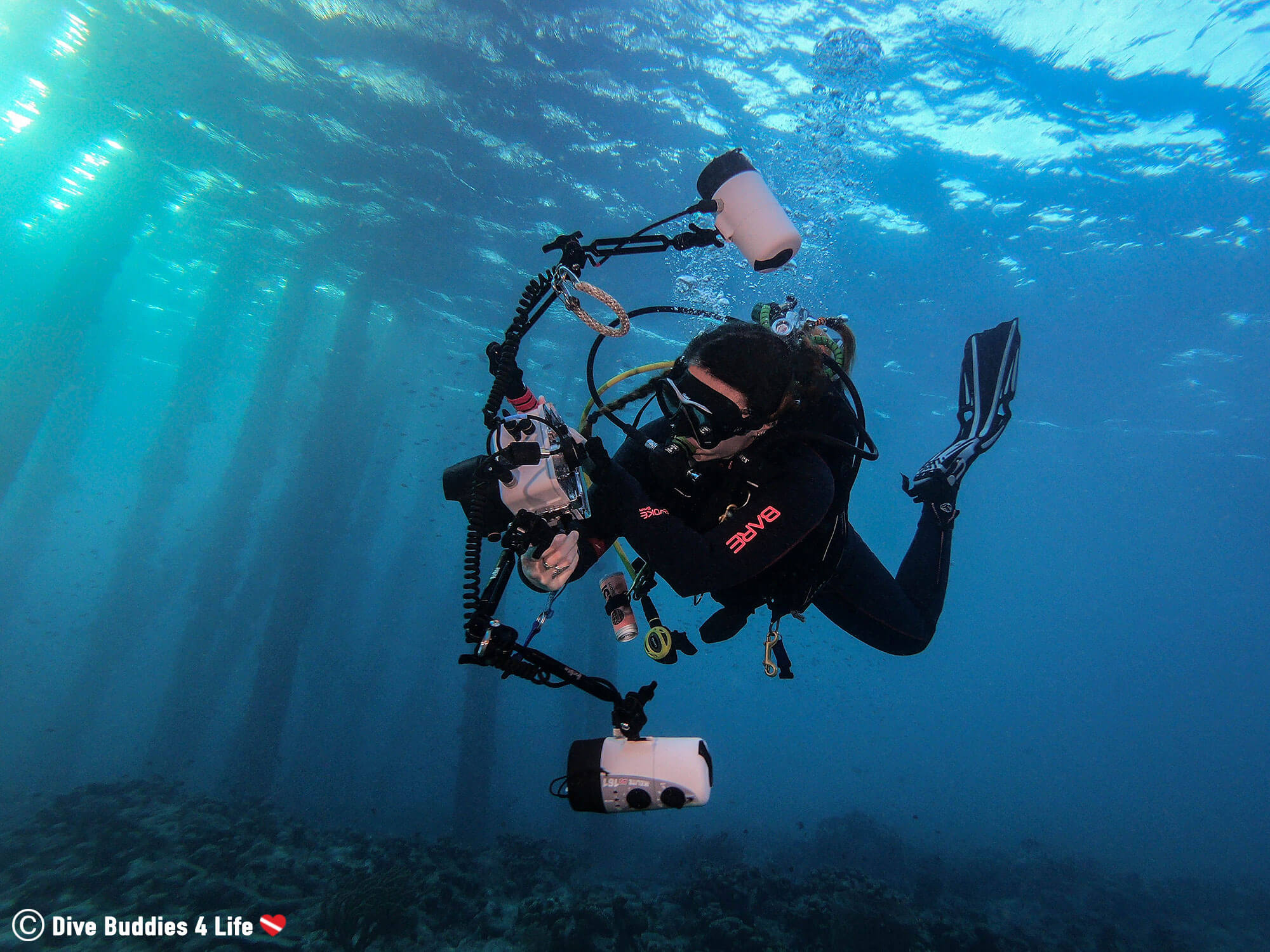
When you look at a map of Bonaire, you can quickly see that it isn’t big by any stretch of the imagination. Overall the island dive sites can be split into six distinct areas; Washington Slagbaai National Park, North Bonaire, Central Bonaire, South Bonaire, East Coast Bonaire, and Klein Bonaire.

Slagbaai National Park is located at the northernmost tip of the island. This National Park was first established in 1969 as a nature sanctuary for endemic and endangered terrestrial species of Bonaire. There are two routes through the park, a short and long loop. Both paths allow visitors to enjoy spectacular views, secret coves, white sand beaches, and unique nature.
Scuba diving the National Park can be done at various dive spots along the coast. However, most sites are exposed to tides and current, and should only be attempted by experienced divers. In terms of marine life, the coral in Slagbaai isn’t anything to write home about, compared to the rest of the western dive sites, but the area is better protected than the rest of Bonaire, and hence species like the parrot and puffer fish tend to grow significantly larger.
Dive Buddies 4 Life Favorite Slagbaai National Park Dive Sites: Our two favorite Slagbaai dive sites were Playa Funchi and Wayaka. Unfortunately, the water was too rough to enable us to dive Playa Benge and Boka Bartol, both of which are said to be some of the best dive sites in the park.
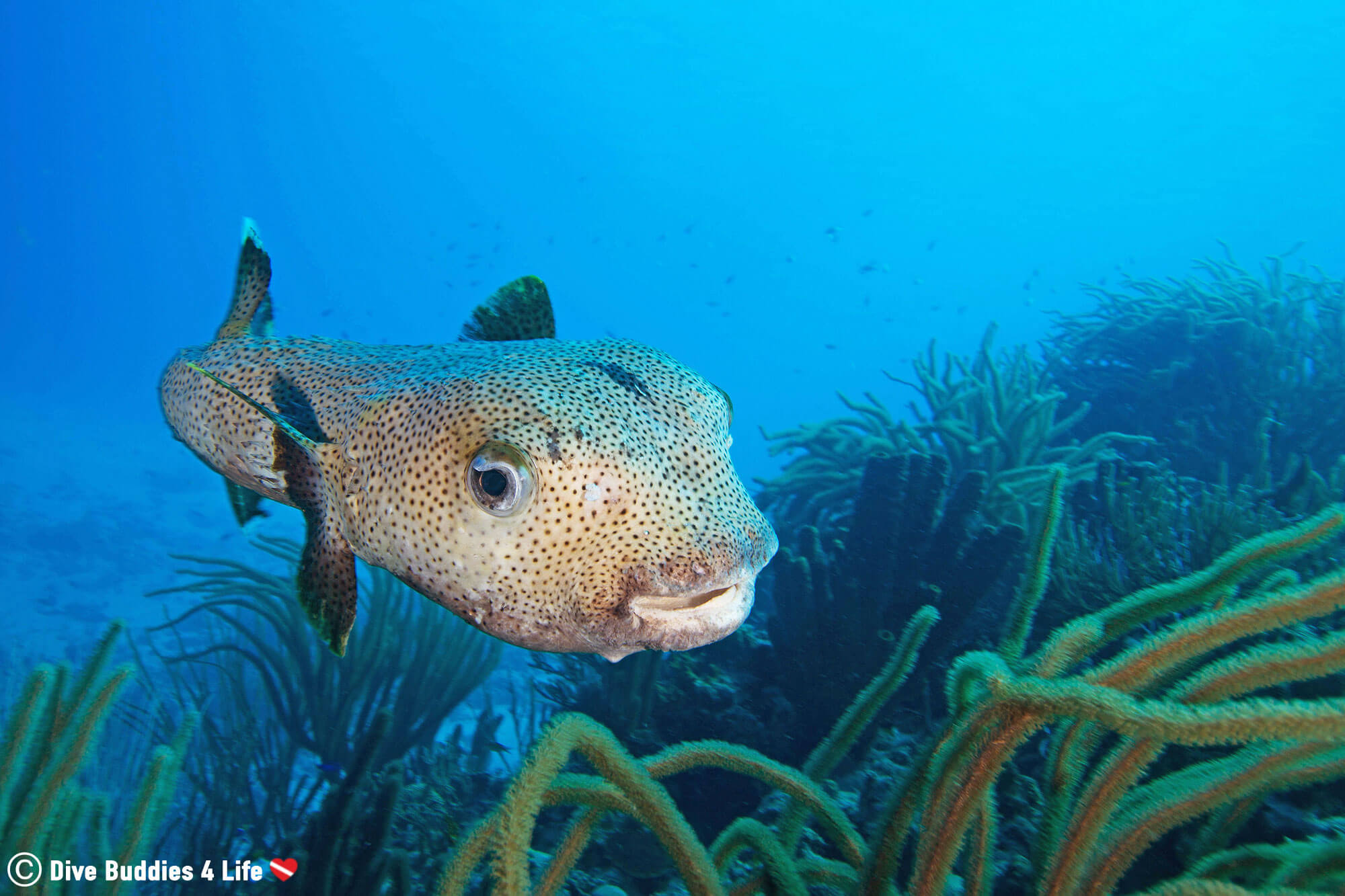
The northern diving region of Bonaire is classified as any dive site that is found outside of Kralendijk and on the north/west coast, except for dive sites in Slagbaai National Park.
To the north, scuba divers will immerse themselves in a hilly underwater topography entirely different from the south and central parts. From small terraces to jaw-dropping walls this dramatic landscape weaves in and out following the steep coastline. Embedded in the northern ridges copious amounts of coral colonies cover the outcroppings, dominated mostly by star and brain coral.
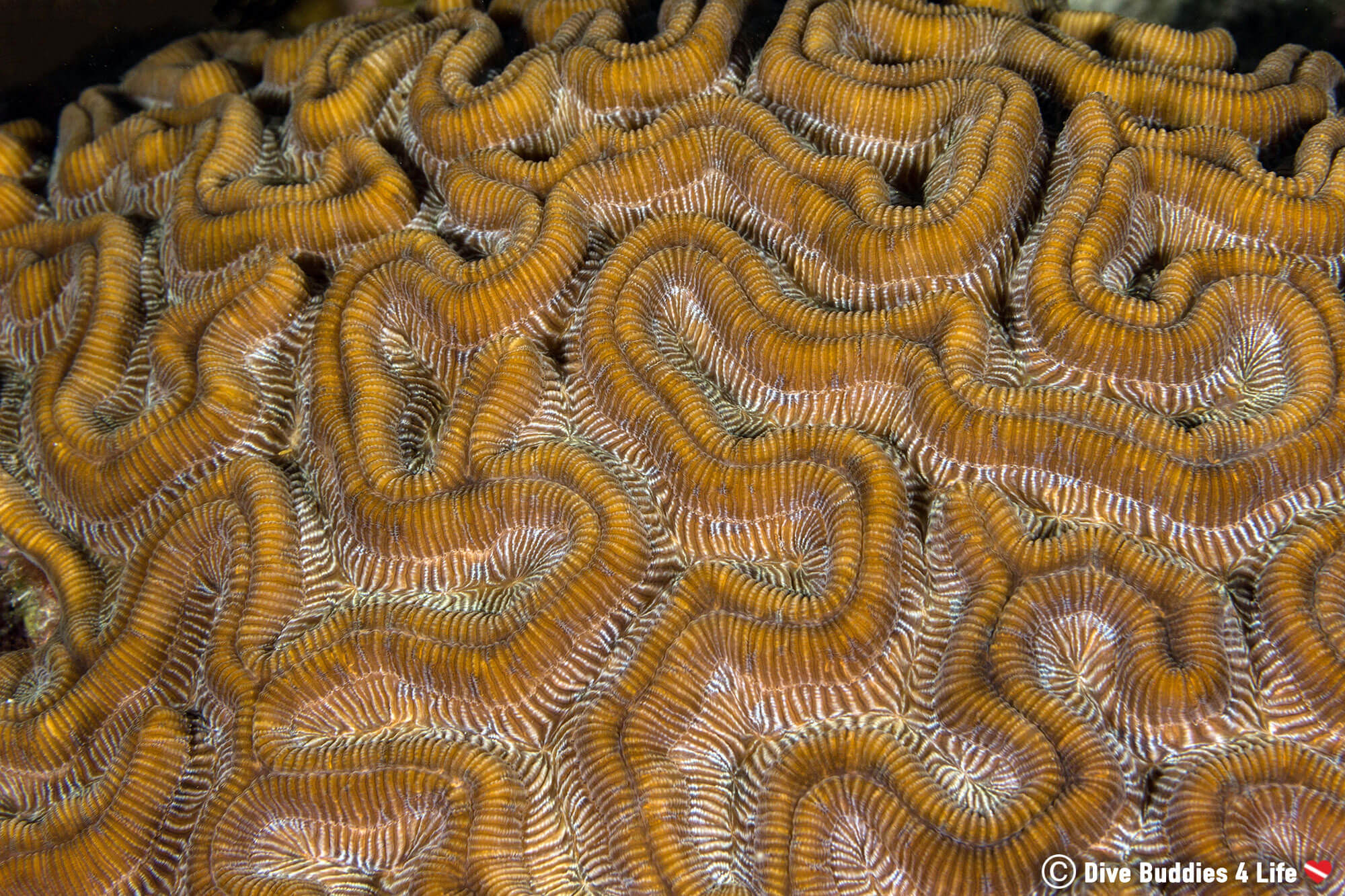
Along with the typical Caribbean reef fish, on the northern coast of Bonaire, friendly sea turtles can be observed in the soft coral at sites such as 1000 Steps and Karpata.
Dive Buddies 4 Life Favorite North Bonaire Dive Sites: Toward the northern part of Bonaire, our all-time favorite site is Karpata. Equally as stunning but slightly more challenging is a drift dive from Dania’s Leap to Karpata. To do this drift you drop your gear and dive buddy off at the unmarked Dania’s Leap trail, drive and park at Karpata, then head back to the dive start point which is roughly about a 5 to 10-minute walk.
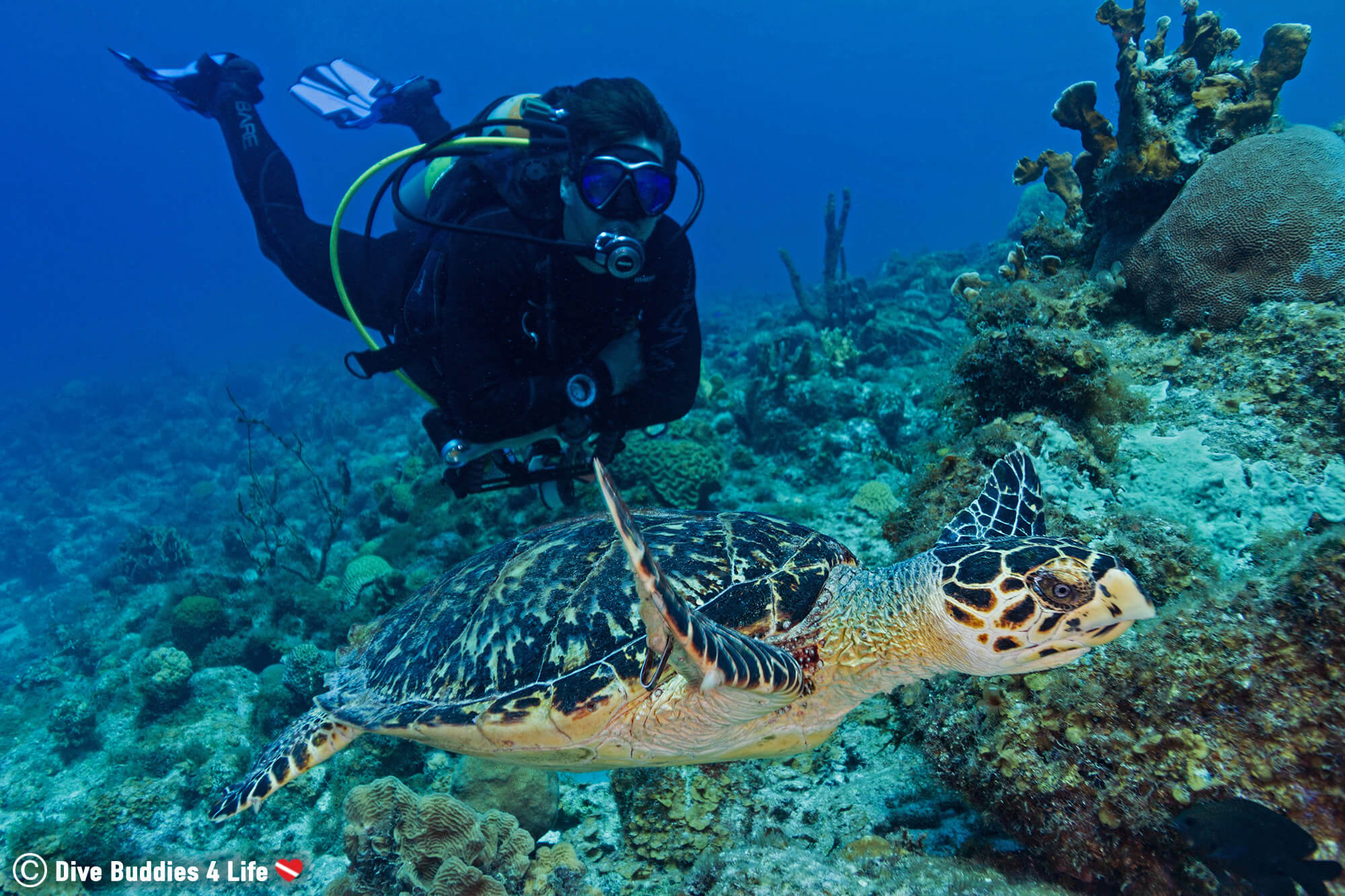
The central dive sites of Bonaire are the ones that can be found along the coast of Kralendijk, Bonaire’s largest city.
Many of the central dives sites are house reefs, found in the backyard of dive shops and commercial hotels. Trying to locate the entry point of these busier diving locations can be slightly intimidating, however, unless it is private property, there should always be an accessible entry for any divers who wish to explore the sites, regardless of if they are staying or using that particular hotel or scuba outfitter.
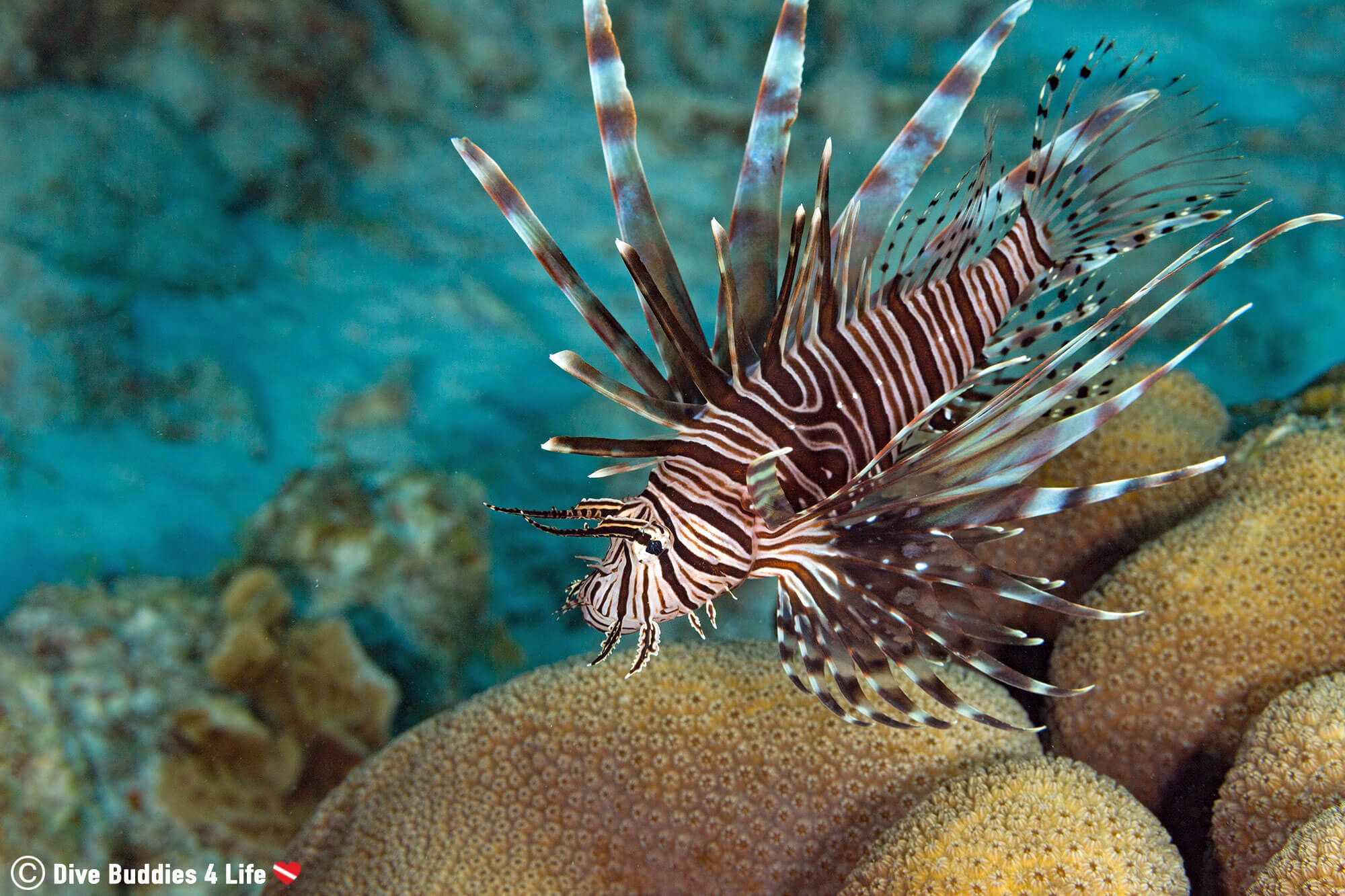
The marine fauna in the central region of Bonaire is once again your typical reef species, but significantly more macro focused. Because there is more boat traffic, fisherman and people who frequent the dive areas, large fish species tend to stay away, and the coral reef had receded a little further out.
Watch out for little critters like flamingo tongues, crabs, brittle stars, blennies, and nudibranchs which are hard to see in the distractingly textured coral. That being said there are still larger animals like trumpet fish, grunts, parrotfish, and tarpon, that use diver lights for hunting at night.
Dive Buddies 4 Life Favorite Central Bonaire Dive Sites: Windsock beach was our top choice for dive site in the central part of Bonaire. It may be a busy area, especially on weekends, but this location is a fantastic option not only for a day dive but also for a night dive. The pier makes for easy navigation and the underwater landscape is patched with rocks and coral making it good for both macro and wide angle photography.
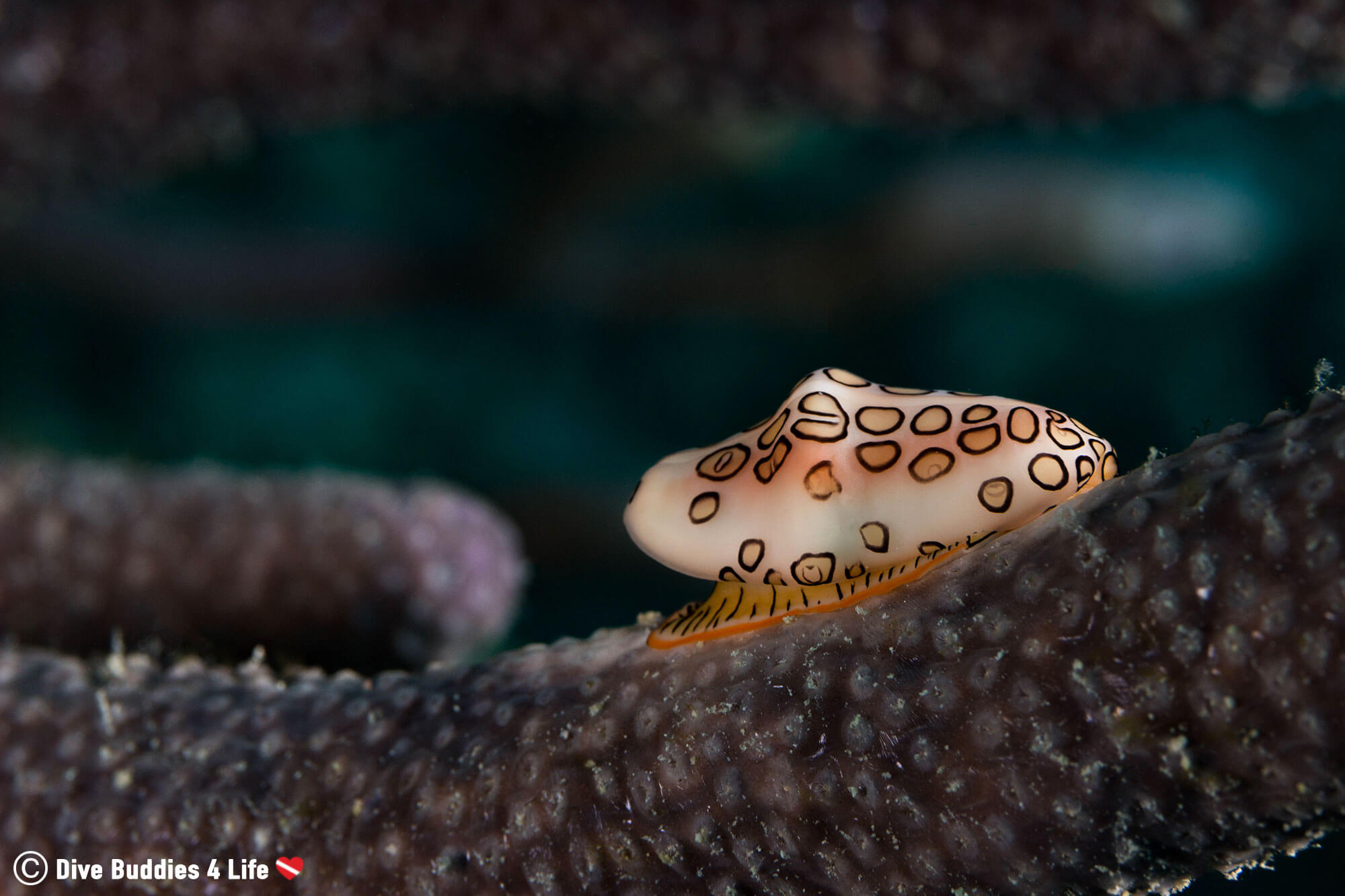
The southern diving region of Bonaire is any dive site that is found outside of Kralendijk and on the south/west coast spanning down to just before the Willemstoren Lighthouse, which designates the start of east coast diving.
Just like the rest of the west coast, southern Bonaire diving is equally as beautiful filled with reefs, sponges and many of the same species. At times there can be trickier currents which may not be visible from the surface, and it is worth noting that a fair number of the sites are labeled as intermediate level dives.
Occasionally manta rays, eagle rays, and sharks are spotted along the south coast, mainly as you get closer to the lighthouse point where east Bonaire meets west Bonaire, and the many ocean currents converge into one big productive mass.

Hilma Hooker
One of the most notable south Bonaire diving location and the only wreck accessible to recreational divers is the Hilma Hooker – a cargo-ship-turned-drug-smuggler.
The Hilma Hooker was a 236-foot Dutch freighter build in the Netherlands. Over the years of her life, the ship has changed hands and known many names. In the summer of 1984, Hilma Hooker was towed to the main port of Kralendijk after suffering technical problems off the coast of Bonaire. Facing customs and FBI scrutiny after failing to produce proper documentation, the ship was searched, and 25,000 pounds of marijuana were found stashed behind a false bulkhead. The drug bust, lead to the immediate arrest of crew and impound of the ship while authorities searched for its owners.
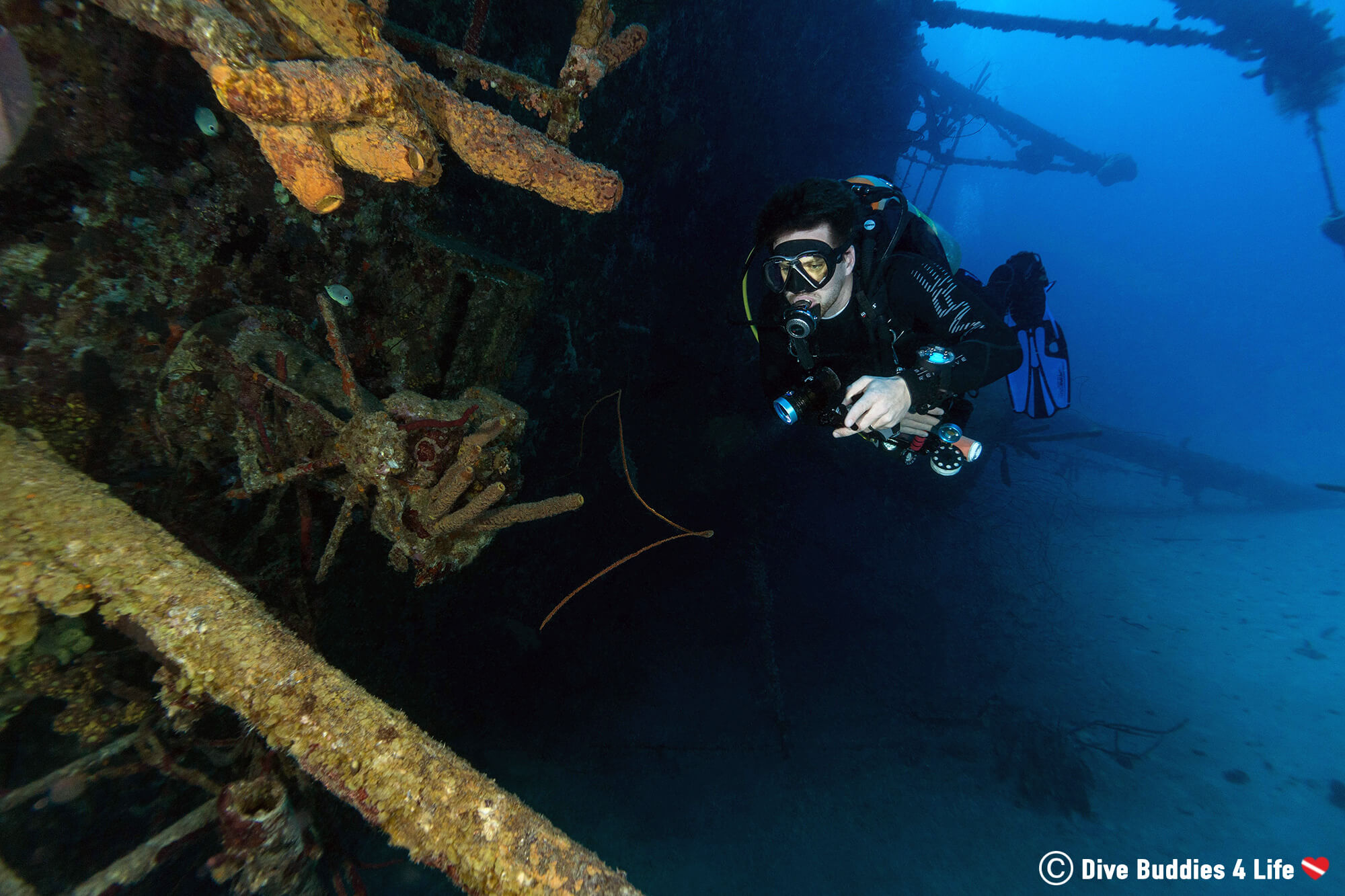
When no owners stepped forward to claim their vessel, the Hilma Hooker eventually fell into disrepair and began costing authorities more money to keep it in custody at the pier. Eventually the Bonaire tourism bureau and dive shops got together to establish an out of the way reef-free place to dock the ship, so that if – or in the Hilma’s more likely case when – it sank to the bottom of the sea, the boat wouldn’t cause and navigational problems or destroy any reefs in the process.
Interesting Fact: It is rumoured that the pumps that kept the Hilma Hooker afloat didn’t malfunction, but were deliberately sabotaged by impatient scuba divers readily anticipating the sinking of their new dive attraction.
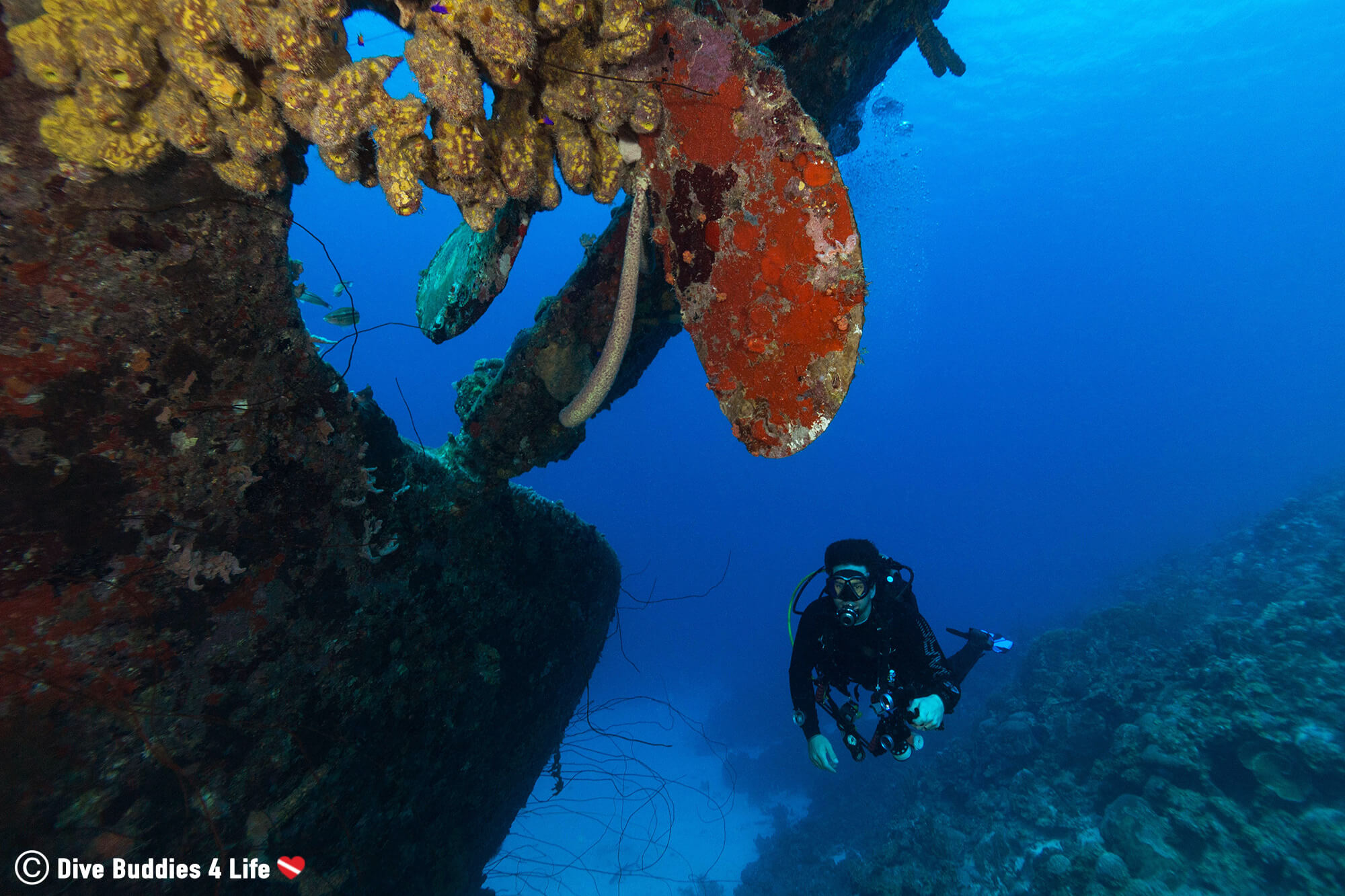
Since it’s sinking on September 12, 1984, the Hilma Hooker now rests on its starboard side with its port side 18 meters (60 feet) below the surface and its mast in 30 meters (100 feet) of water.
Dive Buddies 4 Life Favorite South Bonaire Dive Sites: The southern region of Bonaire offers some impeccable diving and given that our island accommodations were down in that area, we had a tendency to dive the south more often than not. The Salt Pier and Red Slave are our first picks for dive sites based on the high probability encounters with rays and tarpon. We also liked that the Hilma Hooker site because it’s a shipwreck – changing the pace from the routine reefscapes we had come to know and love.
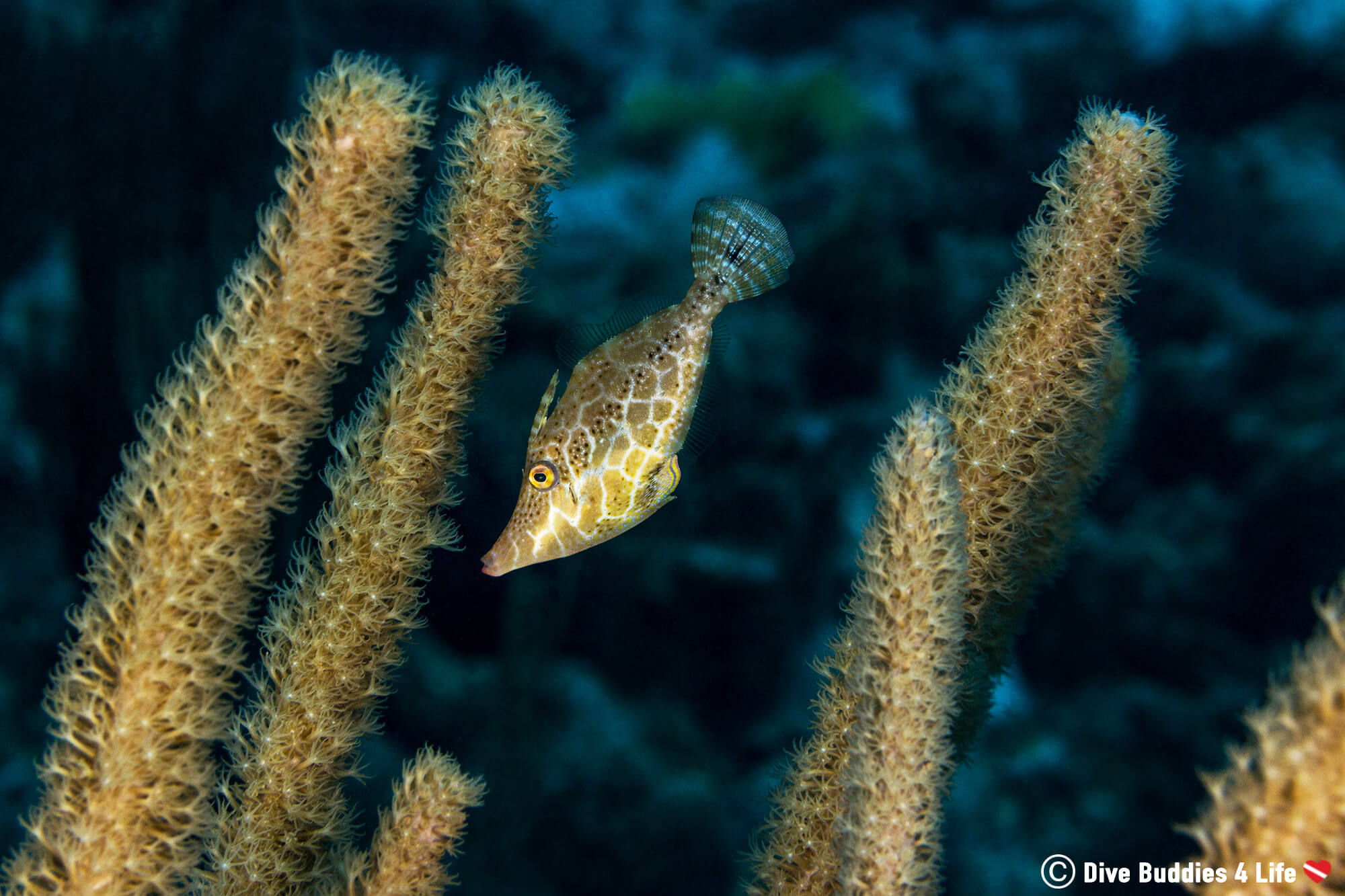
The east coast of Bonaire is known on the island as the “wild side” for a reason. Open to the harsh elements of the Caribbean sea, jagged cliffs, steady trade winds, and ever-present waves make diving on this side of the island a very daunting experience – and that’s not even mentioning the unpredictable rip currents and changing tides.
All exhilaration aside, once divers submerge underwater, the rewards are stupendous. Giant turtles, rays and even sharks call this side of Bonaire home giving “Wild Coast” divers that adrenaline surge they won’t quite get on the west.
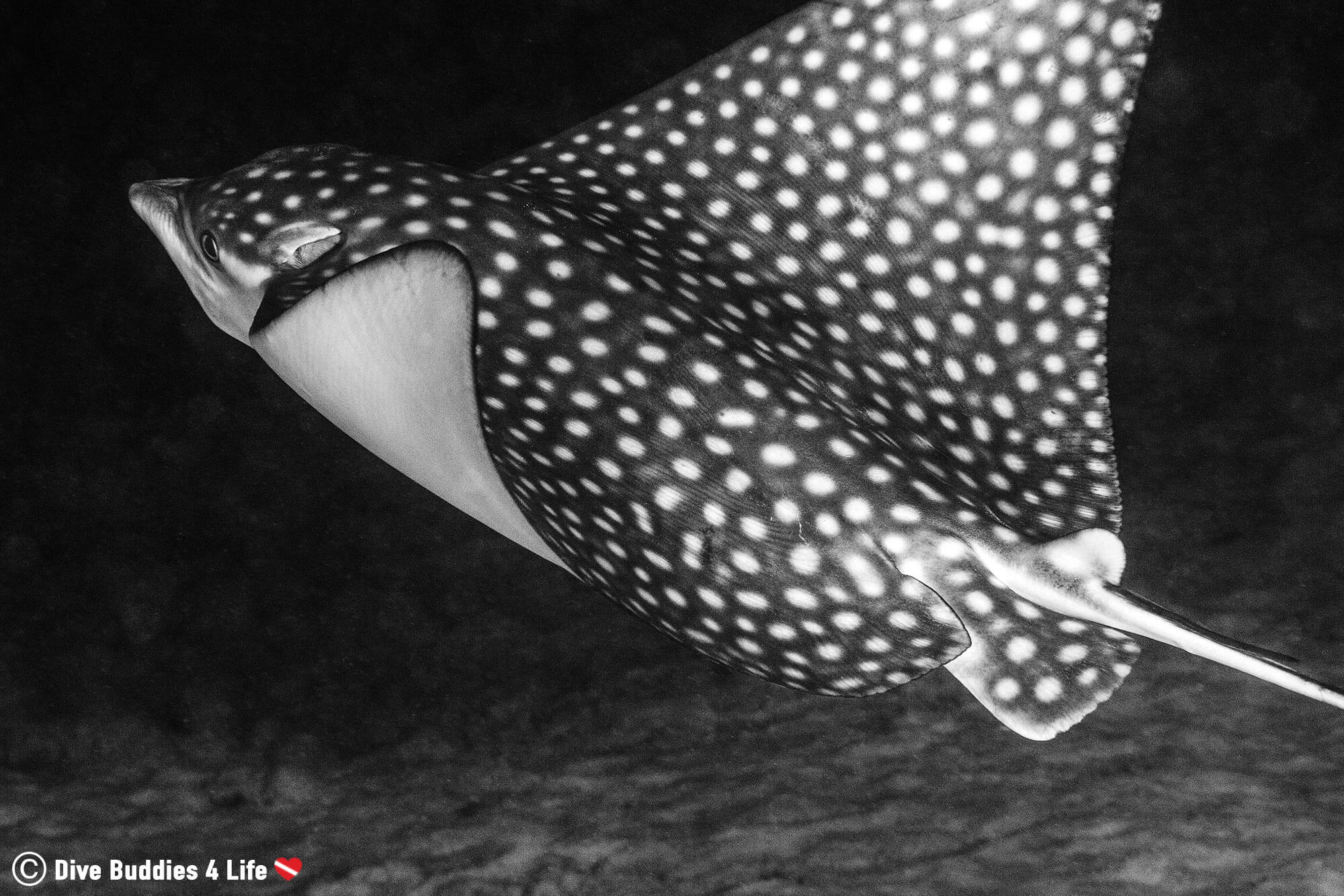
On the east coast, some of the dive sites can be accessed from the shore in calmer conditions, while others are only reachable by boat.
If there’s one thing to highlight about east coast diving, it’s that unless you are an exceptional diver who is familiar with the area, no one should attempt east coast diving without an experienced guide. It’s dangerous, unpredictable and can quickly whisk you out to sea.
Dive Buddies 4 Life Favorite East Coast Dive Site: East coast diving on Bonaire is least familiar to us, as we have only done a handful of the nine dive sites. We loved our boat dive in Turtle City as we found ourselves completely surrounded with green and hawksbill sea turtles for the entire duration of the dive. In terms of shore diving, when the wind permits Baby Beach may have barren coral coverage however distant shark sightings (reef and nurse) are a common occurrence at this dive site
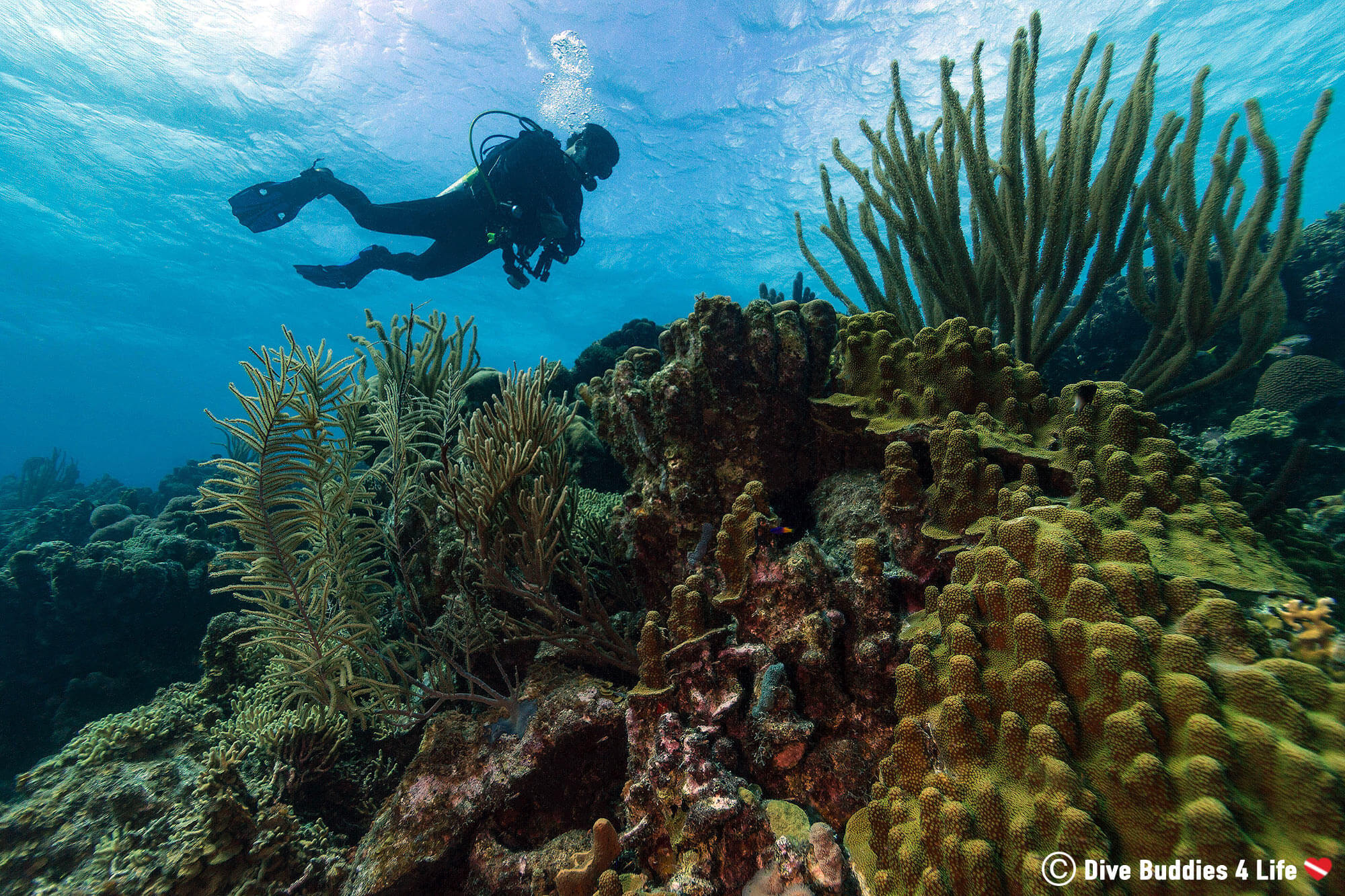
Mainland Bonaire is a shore diver’s dream, but if you want to change things up and try some boat diving, Klein Bonaire is a tiny uninhabited islet that sits about 800 meters west of the coast.
Klein Bonaire, Dutch for “Little Bonaire,” is part of the protected Marine Park and is a primary nesting ground for sea turtles in the summer months. Having no running water, bathroom facilities or infrastructure, the two main draws to Klein Bonaire are for the scuba diving and snorkeling.

Because of it’s harder to access nature, on Klein Bonaire, the reefs are even more pristine than on the mainland. Vibrant and colorful coral will fill your mask. The island offers dive spots for drifts and others with barely any current. Most dive shops offer regular boat dives to Klein for between USD 25 to 50$.
Dive Buddies 4 Life Favorite Klein Bonaire Dive Site: During our stay on Bonaire we never had the chance to venture out to Klein Bonaire for a dive, however, we have it on good authority that Sampler and the Forest are neat spots to check out.
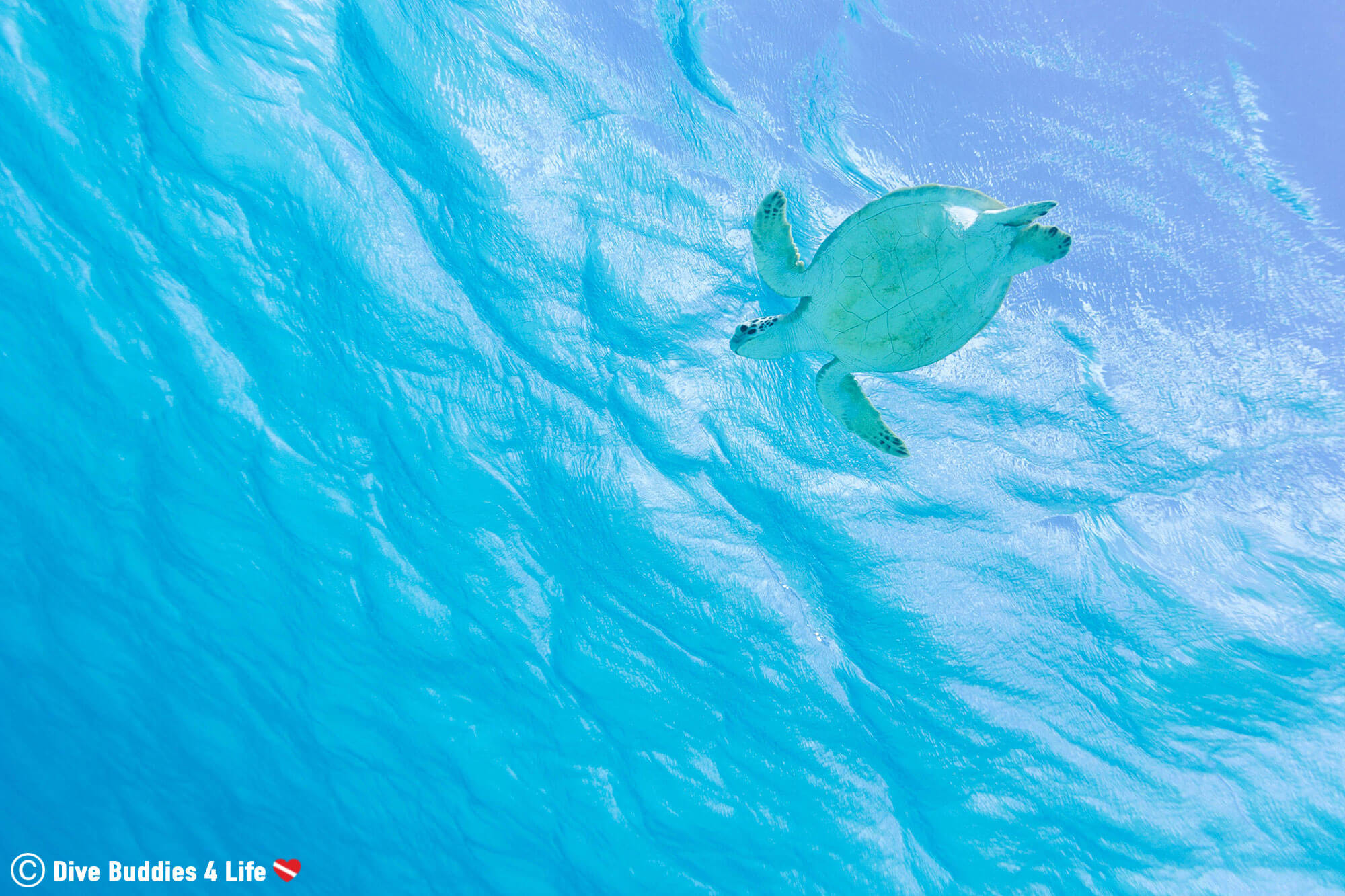
There are some places in this world with a vibe so unique and dreamy that you feel instantly infatuated within moments of even arriving. Bonaire is one such place.
Like something from a fairytale, what makes Bonaire so enjoyable as a dive destination, is the fact that it is not just hardcore diving, but that there are also good surface interval activities as well. Sometimes it’s nice to get your head out of the water and visit the terrestrial part of a country.
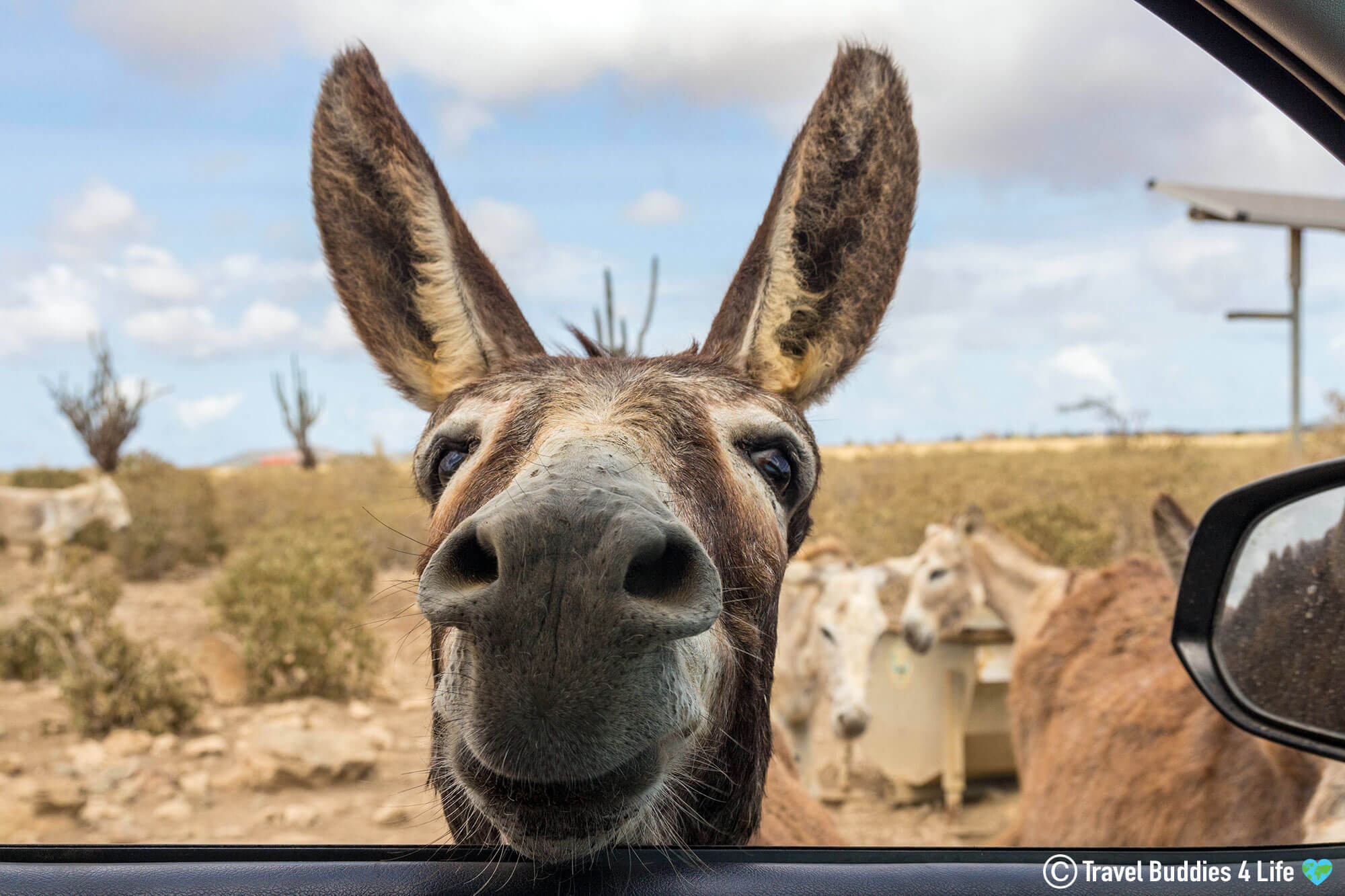
After a solid month of falling head over heels into Bonaire, words cannot describe my powerful sentiments towards this Dutch island. If you are thinking about traveling here – start saving up. If you are a scuba diver looking for a dive vacation – what are you waiting for? GO!
As a water lover, traveler and dive fanatic, I can’t vent more about my love affair with Bonaire. And between bouts of homesickness that I now have for this place, I can only vouch that one day soon we will be back to this incredible slice of paradise.
With over 100 shore diving opportunities on an island that covers less than 288 square kilometers, Bonaire is a dream destination for traveling scuba divers. Animals, reefs, wrecks, visibility… Is there something this place doesn’t have?? If you’ve visited and dived this Dutch Caribbean island, what was your favorite site?
Writers Note: This post may contain affiliate links. We will make a small commission if you make a purchase through one of these links, at no extra cost to you. See full disclosure and disclaimer policy here.

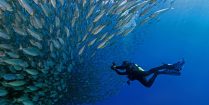
Submerge yourself into Bonaire's underwater world with this scuba bucket list. It will leave you wanting more from the coral capital of the Caribbean.

There are many ways to fight back against pollution and on Bonaire, this takes the form of scuba diving cleanups.
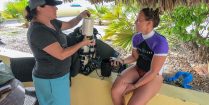
Bonaire TEK is an annual October occurrence, where Buddy Dive Resort partners with leaders in the tech diving industry for a week of technical dive demonstrations, equipment trials, presentations, training ins and outs, and camaraderie.
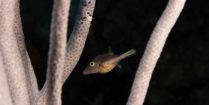
Whether your diving with turtles or admiring coral reefs, get ready to be wowed by the underwater beauty of Bonaire, the shore diving capital of the Caribbean.
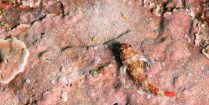
Forget the colorful piñatas and all-you-can-eat tacos, when in Mexico's coastal town of Zihuatanejo, it's all about the scuba diving!
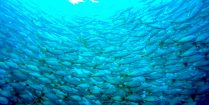
Bat Islands are a collection of volcanic islands off the coast of Costa Rica with some pretty unique diving.
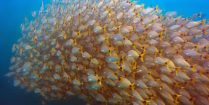
The sea life was plentiful at the Catalina Islands. It was the perfect spot to introduce Dad to Costa Rica's underwater playground!
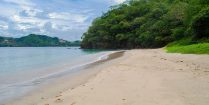
Slipping into the Pacific waters off Costa Rica for a snorkel is a relaxing way to spend the day. Here are the best places around Playa del Coco.

As one of the sunshine states top shore diving destinations, Blue Heron Bridge offers some of the best diving in Florida. Mud, beaches, wrecks and small critters, no matter where you dive under the bridge, there is so much to see, explore and photograph.
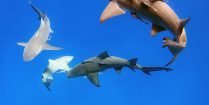
Sitting pretty right next to the gulf stream, Jupiter is known as one of Florida's best shark diving location. Drift along in the current as you enjoy an up-close encounter with the ocean's apex predators.
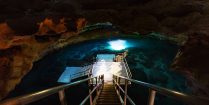
Dark, ancient and mysterious are a few words that can be used to describe the Devil's Den cavern in Florida. Find out what it was like to visit this world-class tourist destination and dive this prehistoric spring system.
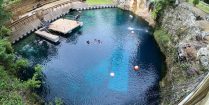
Florida may be known for its ocean coast, but this southern state is also home to some of the best spring and cave systems in the country.
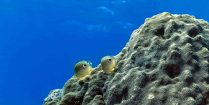
The tropical oasis of Key Largo is a scuba diver's delight. Night dive, reef dives, and wreck dives are all right at your fingertips ready to be explored.
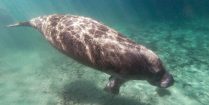
Offering topside beauty and underwater magic, escape to Florida's freshwater springs and snorkel with one of the most majestic marine mammals on the planet.
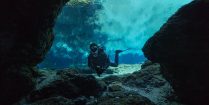
The crystal clear water of Ginnie and Devil’s spring systems is arguably some of the best freshwater diving in all of Florida. As a scuba diver heading to the sunshine state, make sure to put this spot on your travel itinerary!

2 comments...
Read 2 comments...